Black, white and opalescent blues
The South Australian mining town of Mintabie is to be returned to the Anangu people in a move that has exposed deep faultlines.
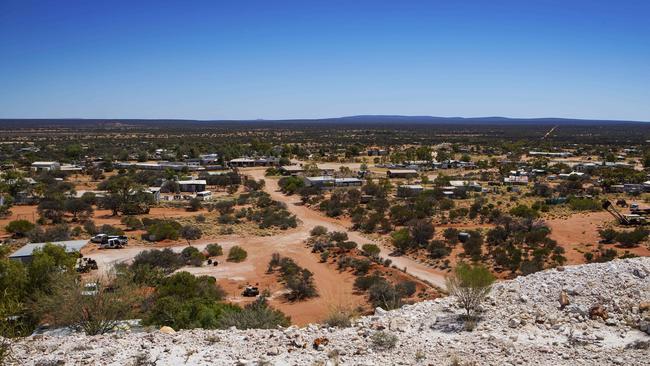
For Luka Sumanovic, the opal miner and smiling face behind the bar at remote South Australia’s Mintabie Hotel, freedom is more precious than any of the sparkling gemstones he’s pried from the rocky earth.
Freedom, the publican says, is an attribute he thought Australia had in spades, so after his father was executed by the communist regime in Croatia, it was Australia Sumanovic chose to seek out a new life.
Since the pub opened in 1981, the 76-year-old has found solace and family in the close-knit community he helped build. Now the place that has been his home for nearly four decades is fast-tracked for extinction.
Last year the South Australian government moved to terminate the lease arrangement of the town eight years early.
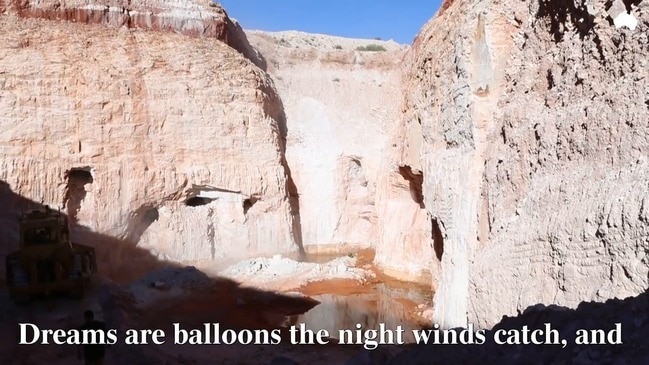
Come July 1, all those living in the predominantly white township must depart, leaving their homes and businesses behind and handing back control to the executive board of the Anangu Pitjantjatjara Yankunytjatjara Lands.
“This was everything to the town,” Sumanovic tells Inquirer, gesturing to the wood-panelled decor of the pub’s dining room, littered with bright bunches of fake flowers. “The church, the meeting place, the beginning.
“When communism took over, my father didn’t believe he should give his property to the state and they killed him for it … it makes me emotional because now it looks like that’s my destiny, too.”
Mintabie, 1000km north of Adelaide, is accessible only by an ungraded dirt track. Visitors are lucky to pass more than a few burnt-out cars on their way into town, which was once the nation’s largest opal producer.
Those who make it are met with dusty streets lined with “camps” — rough-hewed tin shacks that have been renovated inside to include new features — and rusty automobile carcasses.
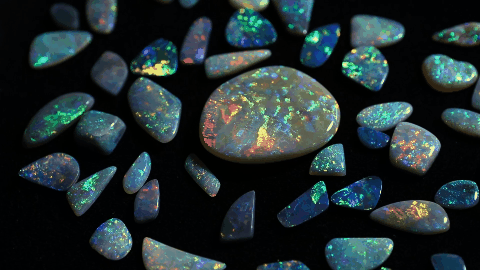
If you look closely enough, evidence of the town’s colourful past remains. From the fading “Opal for Sale” signs to the town’s sports oval — which would blend into the surrounding shrub land if not for the goalposts sprouting from the tall grass — there are clues all around.
It’s no oil painting, but for at least 30 people, Mintabie is home. Its remaining residents are like desert-hardy plants. They have withstood the harsh conditions over time and are fiercely proud of it. Ask any of them and they’ll become misty-eyed when recalling the days prospectors, flush with promise, arrived in their droves across the red dust.
But despite the fiercely blue sky, a storm cloud has been hanging over this town. In 2018, the Weatherill government released a scathing review of the township’s management and decided to revoke its lease for good.
The government had been acting as an intermediary between the APY Lands and the residents of the town, providing rolling leases since the 1980s.
The report, commissioned by the Turnbull government after one of the town’s general store owners was found guilty of rorting nearly a $1 million from the bank accounts of the local Anangu people, raised “serious concerns” about drug dealing, lawlessness and violence.
The 14 recommendations, which include the option to close the town and hand control to the APY Lands, were adopted in full by the state government and are being honoured by the Liberal Mining and Energy Minister Dan van Holst Pellekaan.
Mintabie’s mostly white residents have long been accused of supplying drugs and alcohol to those living in the nearby Aboriginal communities. They deny the claims. But if you ask around, you will hear that there are at least two dealers living in town who, despite “being known” to police, have evaded prosecution.

While it’s now just a matter of time before the town’s management reverts to the local APY board, the town’s lawyer, Todd Grant, last Sunday announced new details about his plan to thwart the pending eviction of residents.
In an emotionally charged meeting held on the eve of what was supposed to be a preliminary round of evictions, Grant said he would challenge a 1985 High Court ruling allowing the APY to discriminate against other communities, including other Aboriginal communities, to protect their culture.
While the final push was welcomed by many in the crowd, others voiced concerns the damage inflicted by the damning review had already been done.
Among them was Mary Nelson, who said she had been embarrassed by the report’s “ridiculous and outrageous” allegation that female residents of the town were prostituting themselves.
Another opal miner, Jamie Wilson, said he felt misunderstood and unsupported by the government. “We’re supplying our national stone and something that makes Australia famous. They should support us and say ‘good on yers’,” Wilson said to a round of applause.
Fewer than 12 hours after the town meeting, the Department of Energy and Mining relented on this first round of evictions.
Those who had been late in renewing their lease payments, and had been ordered to leave by February 11, were told they wouldn’t be evicted that day but must advise the department of their relocation plans by month’s end.
But the stress of knowing they may be forced from their homes has already claimed casualties, such as local legend and Order of Australia recipient Bill McDougall. Since news of the town’s closure, the 94-year-old’s health deteriorated so rapidly, he went from “carting around 100-gallon drums” to having to live in a cramped hospital room nearly four hours’ drive away in Coober Pedy.
Many in the town have reported a spike in criminal activity. Mintabie Miners and Progress Association chairwoman and owner of the Mintabie Trading Post, Robyn Lloyd-Groocock, claims the Anangu have taken news of the pending closure as a green light to do “whatever they like”. Lloyd-Groocock packed up her things and left the town for good two weeks ago, saying her business had became “unviable” due to a steady stream of break-ins and ransacking.
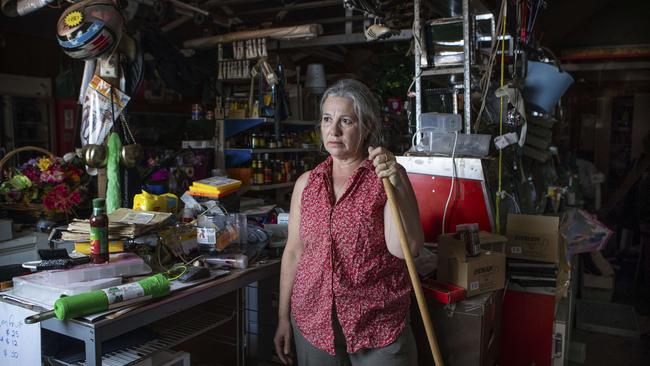
This week, after unbolting the screws she had drilled into the door frame, she leads Inquirer into what was once a “thriving business”.
“Looks like they didn’t get in, then,” Lloyd-Groocock says, looking at the debris strewn around the floor from previous break-ins. “All these shelves used to be full.”
In November and December, six people were arrested following 24 reported break-ins. Police reports indicate goods worth more than $100,000 were stolen.
The residents say they fear for their safety and point to the increasing divide between the nation’s regions and outback.
When residents call emergency services they are transferred to a police station in Port Augusta, 812km away. Overwhelmingly, there’s a sense of being left behind.
Dylan Brown, a towering 193cm, spends his days crouching beneath an ultraviolet light, his teeth and eyes flashing a brilliant white as his arms reach out like tentacles before him. He deftly handles the constellation of rocks that speed before him on the conveyor belt, searching for any specimen with a thin glowing line.
“You’re looking for a vein like this,” he says, holding a stone under the spotlight for a second before passing it into a bucket to his left. “I don’t like people much but here they let me be.”
The 18-year-old from Adelaide has been working on and off in the town as a professional “noodler” (fossicking) for two years, ever since his friend’s uncle took him under his wing.
“I’m good at it because I have long arms,” Brown says proudly. “It’s definitely kept me out of trouble. My mates call me ‘Dylan the opal miner’.”
“I’d move here if it wasn’t closing,” he says. “The opal bug gets you good. It gets under your skin.”
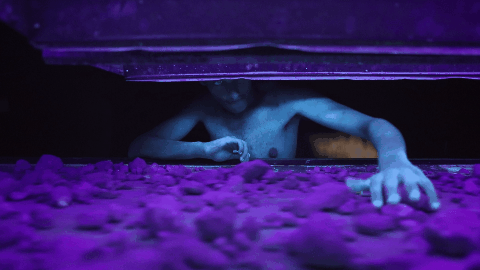
Opal miner Kevin Davies, 66, loves nothing more than visitors rolling into town. His passion for Mintabie is palpable and he offers free tours to anyone who dares step into his truck.
First up is a quick drive around town, which includes detailed commentary about where lucky miners of old found fortune.
“There was $11 million found there,” he says, pointing to a crater. “And $8m there.”
One of Davies’ favourite things to do is to take people underground into the opal “drives”, or deep channels carved into the rock.
Walking in, visitors are immediately met with a rush of cold air. It always comes as a welcome relief after the heat outside. With a flick of his torch, he shows the different sediment in the rock face — layered like birthday cake.
Mintabie has been home for 15 years and Davies is reluctant to leave but he says if he’s forced to, he will resettle in another opal town. “Once it gets into your system, it’s hard to let it go.”
Speaking with locals, it’s clear the miners’ lifestyle is one of the town’s drawcards.
Residents work and operate on their own time and terms.
A “finders keepers” attitude prevails among the township and when someone leaves, residents are likely to descend on abandoned properties in search of possible treasure.
The events of September 11, 2001 changed the world forever and the effect rippled over the Pacific Ocean, across the sand dunes of Australia’s central desert and into the town in the form of more stringent restrictions on the use of explosives.
The expense and difficulty in sourcing the opal-mining staple coincided with an increase in diesel prices, another blow for a profession in which a drill guzzles thousands of litres a day.
If you ask about the “good old days”, you’ll hear tales about how Malaysian buyers would arrive at all hours of the day and night in planes that roared on to the now defunct tarmac, ready to exchange briefcases full of cash for Mintabie treasure.
But the chances of finding a life-changing deposit are drying up, locals say.
Bulldozer operator Mark Hoobin, who has worked in the opal mines since he was 16, describes how, at the town’s peak, each of Mintabie’s cultural groups would try to outdo each other on their respective national holidays.
“On Anzac Day we’d try to beat the Croatians at their own celebrations by letting off as much dynamite as we could,” says Hoobin. “They were so big, you could see the ripples from the explosions.”
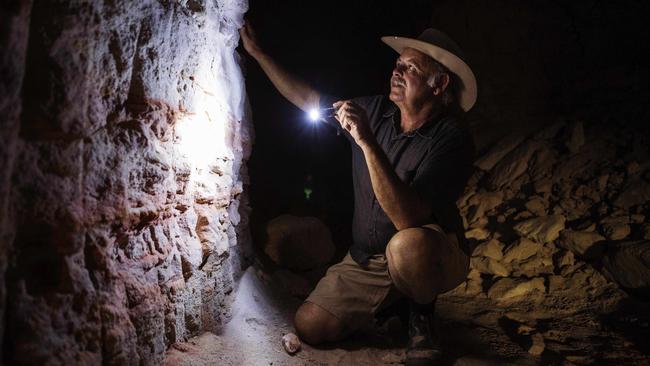
Like many of the small opal-mining towns scattered across the outback, Mintabie is as rich in urban legend as it is in dazzling gemstones.
From the tale of Jimmy McGris and his private plane that couldn’t take off for the weight of the opals on board, to the legendary two-up games where participants played for piles of cash. But there’s one story that’s outlived them all, and that’s The Dreaming.
Long before the white settlement was founded in the early 1980s, the Yankunytjatjara clan is said to have camped under the shade of gumtrees long since gone.
The handful of surviving elders, who remember the time before, speak of galahs and yellow-tailed black cockatoos soaring overhead.
If you strike up a conversation with any of the pub’s patrons and ask them how opal was discovered here, they’ll tell you a savvy prospector showed an Anangu man a handful of glittering stones and he was led right to what is now the Precious Stones Field.
But the once-harmonious relationship, where black and white would “noodle together” on the fields, has clearly deteriorated over time, exacerbated by alleged abuse on both sides.
A relatively short car ride away is Walatina, Aboriginal homeland to the family of the late elder and activist Yami Lester, who was blinded by British nuclear testing at Maralinga in the 1950s and 60s.
Today his granddaughter Kiah Howard and great-granddaughter Lucy Wesley-Cole 8, live on the property full-time. Kiah spoke to Inquirer while Lucy attended a maths lesson with School of the Air, her dogs Milo and Mimili by her feet.
Both attended Mintabie Area School, and Lucy was one of the school’s last students before its sudden closure late last year. She shows Inquirer photos of herself dressed up as Snow White when performing in what would be the last school play to be held in Mintabie’s pub.
Howard, whose mother and aunty were on the board that conducted the review into Mintabie’s lease arrangement, says the decision to return the land to its traditional owners isn’t race related but cultural.
“I don’t know how they can turn around and try to sue APY,” Howard says, taking a sip from her coffee mug. “It just doesn’t make sense to me.
“The traditional owners have been given the opportunity to finally say what they want to do with Mintabie,” she says. “They’ve made their choice and I think people need to respect that.”
The mother of one, who is friendly with many Mintabie residents, says Anangu are split in their feelings about the evictions.
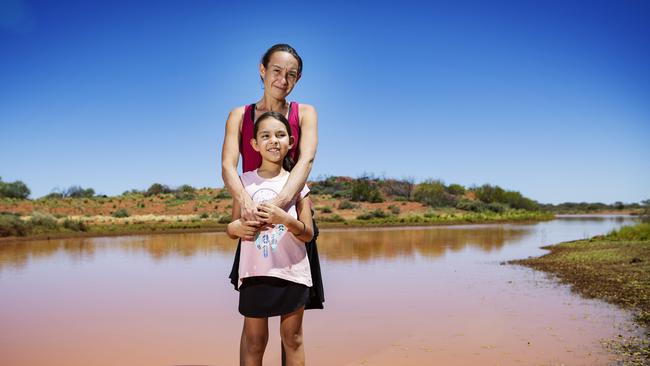
“There are people who are really sad to see that place close,” she says. “But with the shop prices more expensive there than here on the lands, anyone can see the main reason Anangus go there is dope.”
APY Lands general manager Richard King says the real issue at play isn’t discrimination but the fact townspeople have degraded the environment with deep mine shafts and contaminated water to the point that it is “dangerous” for Anangu to practise their traditions there.
“Both Labor and Liberal should be commended for this decision,” he says. “They (the residents) were engaging in various activities that really put Anangu in danger and were taking advantage.
“The real victims are the Aboriginal people, who have had to deal with their culture being abused by this little group that has been allowed to exist on the edge.”
“We need to make the area safe and have a full assessment of the environmental degradation that’s occurred.”
When asked about how the closure of Mintabie relates to the Uluru Statement of the Heart and self-determination, King says tangible action is more important than grandiose gestures.
“Rather than focusing on big-ticket items such as changing the date, Anangu need to focus on where the rubber hits the road,’’ he says.
“There are opportunities out there. They can’t sit on the porch; they have to be out there on the front lines driving this themselves.”
The state government has defended the closure.
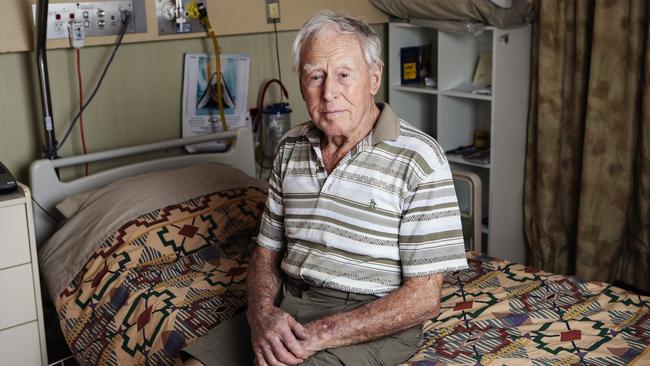
A spokesman for van Holst Pellekaan says: “Mintabie residents have only ever had 12-month licences to live legally in the town, and in June 2018 the state government gave all legal residents of Mintabie a new 12-month licence with advice that it would not be renewed in June 2019.
“Since then, legal Mintabie residents have been offered support to relocate, including access to Housing SA accommodation in Coober Pedy, Port Augusta and other places.”
But Howard tells Inquirer: “It’s just the ignorance that frustrates me,” before handing over a book written by her grandfather.
“I see my family at Mimili, Indulkana and I just think, ‘where’s our future?’ ”
On the book’s final page is a quote: “Help us come together for the land, so that we will keep our country and not lose it.”





To join the conversation, please log in. Don't have an account? Register
Join the conversation, you are commenting as Logout